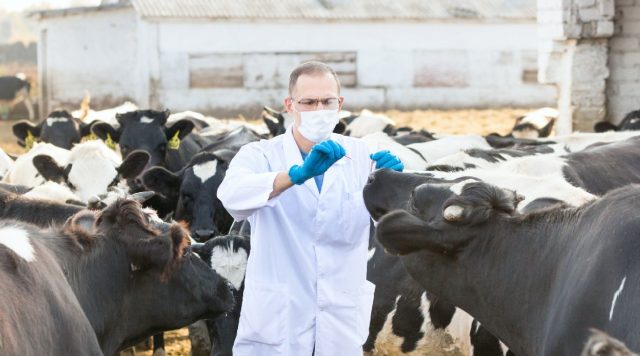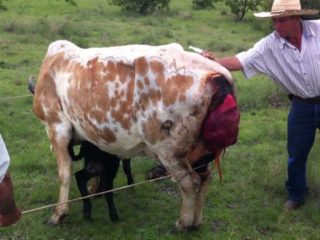Content
Vaccination of cattle allows you to protect animals from a large number of infectious diseases. As practice shows, the spread of infection throughout the body of cattle occurs quite quickly, as a result of which the animal can die several hours after infection. The most effective means of protecting cattle is timely vaccination. Thanks to the introduction of a special solution, cattle acquire immunity, as a result of which the risk of infection is reduced to almost zero.
Cow vaccination scheme
Vaccinations of cattle begin almost as soon as they are born. As practice shows, special attention should be paid to vaccinations of young animals, since they must develop immunity when they reach 2 months. Adult cattle are vaccinated annually. For clarity, we can consider the vaccination scheme for cattle throughout their lives, starting from birth.
It is recommended to promptly vaccinate dry cows and heifers against the following diseases:
- salmonellosis – the first injection should be administered into the body of cattle 60 days before calving, repeated vaccination is carried out after 8-10 days;
- leptospirosis – 45-60 days before the expected time of calving and again after 10 days;
- colibacillosis – 40-60 days before the onset of birth in cattle, the first injection is administered, the next one – 2 weeks later.
Newborn calves are vaccinated according to the following scheme:
- salmonellosis - if the cow was vaccinated before giving birth, then the calves are vaccinated on the 20th day of life. If the cow was not vaccinated in a timely manner, then the first injection is given to the calf on the 5-8th day of life and again - 5 days later;
- infectious rhinotracheitis, parainfluenza-3 - vaccination is carried out 10 days after birth, the subsequent one - after 25 days;
- diplococcal septicemia - vaccination against this infectious disease should be done at the age of 8 days and after 2 weeks;
- foot and mouth disease - if the calf was born in an area with an increased threat of infection with this disease, then the drug is administered on the first day of the animal’s life;
- viral diarrhea - cattle are vaccinated against this disease at the age of 10 days and again after 20 days.
For replacement young stock, the following scheme is followed:
- salmonellosis – when the animal is 25-30 days old;
- trichophytosis - the solution is introduced into the animal’s body upon reaching 30 days or older, the subsequent vaccination is six months later;
- leptospirosis - vaccination must be done immediately as soon as the calf is 1.5 months old, revaccination - after 6 months;
- viral diarrhea – at the age of 30 days;
- infectious rhinotracheitis - according to the indications of a veterinary specialist from 3 months;
- parainfluenza-3 – upon reaching one month, again – after 5-7 weeks;
- anthrax - according to veterinarian indications from 3 months;
- theileriosis – only when indicated, when cattle reach the age of 6 months or older.
As practice shows, if a threat arises, even dairy cows can be vaccinated against foot and mouth disease. Adult cattle are vaccinated once, revaccination is done after 6 months. Subsequent immunization is carried out annually.
Vaccination scheme for heifers and heifers
During the dry period, when a cow does not give milk, a large number of changes occur in her body, which require a certain amount of energy. It is worth considering that during such periods, harmful microorganisms can have different effects on the health of each individual. Also, do not forget about non-calving individuals. In both cases, cattle must receive a drug against salmonellosis, leptospirosis and colibacillosis.
During the dry period, in the interval before giving birth, which begins 2 months in advance, pregnant cows must be vaccinated against salmonellosis. In this case, it is recommended to use concentrated formol-alum vaccine for cattle. It is important to consider that the injection drug is administered to cattle twice:
- the first vaccination is given 60 days before the expected time of calving, using 10 ml of the drug;
- the second vaccination is carried out 8-10 days after the first, in this case the amount of the drug is increased to 15 ml.
This vaccination is also excellent for heifers - cows that will give birth for the first time.
The leptospirosis vaccine is administered directly into the body of a pregnant cow. The polyvalent drug is administered 45-60 days before the expected time of calving. Repeated vaccination is carried out after 7-10 days. For animals aged 1 to 2 years, it is recommended to inject 8 ml of the drug for the first and second time. Cattle over 2 years old are administered 10 ml of vaccine.
Colibacillosis is an infectious disease that causes severe diarrhea and sepsis. This disease, as a rule, often occurs in calves, but as practice shows, it can also affect dry cows.As a preventive measure for colibacillosis, approximately 45-60 days before the upcoming birth, the drug is administered into the animal’s body, and revaccination is carried out 14 days later. In both cases, the vaccine dosage is 10 ml. The drug is administered to cattle intramuscularly in the neck area.
Adult cattle should be vaccinated against foot and mouth disease annually. For these purposes, as a rule, a lapinized vaccine is used. During revaccination, each animal should receive 5 ml of the drug subcutaneously. Many experienced veterinary specialists recommend dividing the vaccine volume - 4 ml injected under the skin and 1 ml under the mucous membrane of the upper lip.
.
Calf vaccination schedules
For the life of calves, several particularly important parameters must be observed:
- air quality;
- animal density;
- presence of dry litter.
By observing these criteria, early disease in cattle can be prevented. The first vaccination of young animals can be carried out after the animals are 2 weeks old. During this period, it is recommended to administer drugs against viruses and bacteria that affect the respiratory system. It is not recommended to administer the injection earlier, as it will not have any effect. If the vaccination is done too late, the calves will not have time to develop immunity by the age of 2 months.
It is necessary to adhere to the following scheme for vaccinating young animals against the main pathogens of respiratory diseases:
- 12-18 days. At this age, it is recommended to vaccinate calves against the following diseases: rhinotracheitis, parainfluenza-3, respiratory syncytial infection, pasteurellosis. To prevent the appearance of rhinotracheitis, use nasal drops - 1 ml of the substance in each nostril. Vaccines against other diseases are administered subcutaneously to cattle in a volume of 5 ml;
- 40-45 days. At the moment, it will be necessary to re-vaccinate cattle against parainfluenza-3, respiratory syncytial infection and pasteurellosis. Vaccination is carried out using the drug "Bovilis Bovipast RSP", the drug is administered subcutaneously, with a volume of 5 ml;
- 120-130 days. When cattle reach this age, young animals on the farm are revaccinated against infectious rhinotracheitis.
If you adhere to this scheme during the vaccination process, you can protect cattle from the main pathogens of respiratory diseases and create the necessary level of immunity by the age of 2 months. In addition, it is possible to prevent the development of infectious diseases in calves until 7-9 months of age.
To prevent major infectious diseases, veterinarians recommend using the following regimen;
- 1 month – carry out vaccination against salmonellosis. Vaccinations against this disease are done mainly in those regions where there is a high incidence of salmonellosis. Before administering the drug to an animal, it is recommended to first check with a veterinarian about the serotype of the pathogen;
- 1.5-4 months – during this period of time, cattle are vaccinated against ringworm and anthrax. Animals must be vaccinated against anthrax annually; the optimal age for calves is 3 months;
- 6 months – from this period, cattle are vaccinated against rabies.If there is a difficult epizootic situation in the region, then it is necessary to vaccinate at 3 months and repeat at 6 months.
By vaccinating cattle in a timely manner, you can prevent the emergence of dangerous infectious diseases that lead to death.
Conclusion
Vaccination of cattle must be carried out on time, according to the veterinary schedule. This is the only way to get a healthy herd, which during the process of growth and development will not be exposed to infectious diseases with fatal consequences. Vaccination is the immediate responsibility of every farmer.











I liked the article, but I would like to know in more detail about bovine rabies